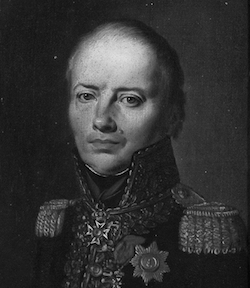General Claude Ignace François Michaud

Born: October 28, 1751
Place of Birth: La Chaux-Neuve, Doubs, France
Died: September 19, 1835
Place of Death: Luzancy, France
Arc de Triomphe: MICHAUD on the east pillar
The son of a clerk, Claude Ignace François Michaud enlisted in the chasseurs of Gevaudan in December of 1780. He was dismissed in 1782 and seven years later in 1789 he took command of the National Guard of La Chaux-Neuve and Châtelblanc. In October of 1791 Michaud was elected capitaine in the 2nd Battalion of Volunteers of Doubs and three months later he became lieutenant colonel of his battalion. For the next three years he served with the Army of the Rhine, and in October of 1792 he was named commander of Delémont. In May of 1793 Michaud help bring Porrentruy into France and the representatives of the people with the Army of the Rhine promoted him to général de brigade. That September he seized the forest of Bienwald and took part in the attack of the camp of Nothweiler and he was then promoted to général de division. The next month Michaud defended Geisberg during the loss of the lines of Wissembourg and then at the end of November he took command of the right wing of the Army of the Rhine.
In January of 1794 Michaud was named commander of the Army of the Rhine in place of General Pichegru. As commander, he seized Fort Vauban, won at Schifferstadt, won at Offenbach, and then in July he was named commander of the Army of the Moselle. With his new command, Michaud won at Platzberg and went on to take Worms, Alzey, Frankenthal, and finally Mannheim in December. Wounded at Mainz by a fracture of the left knee, he left his command to serve in the department of Marne. In May of 1795 Michaud returned to the army and he took command of the 1st Division of the Army of the Rhine and Moselle. In 1796 he joined the Army of the Sambre and Meuse and in 1797 he was named commander of the 13th military division at Rennes. In 1799 Michaud briefly served in command of the Army of England and then in March of 1800 he was sent to the Army of Italy. He led the blockade of the fort of Savona in June and then in July he took command of the right wing of the Army of Italy under General Masséna. Later that year he led the blockade of Mantua and then in 1801 he took command of the left wing of the army. Around this time Michaud took command of a new aide-de-camp, Henri Beyle, who would later become the writer known as Stendhal.
In 1802 Michaud become inspector general of infantry and in 1805 he was sent to Holland to serve as commander-in-chief of the army there. He remained in Holland until November of 1806 when he took command of a division of Marshal Mortier's VIII Corps and he was named governor of the Hanseatic Cities. In March of 1807 Michaud took command of the 1st Division of Marshal Lefebvre's X Corps and he therefore participated in the Siege of Danzig . Afterwards, he served as inspector general of depots at Danzig for a period of time and briefly served as interim commander of Berlin. In January of 1808 Michaud was named governor of Magdeburg and he remained in this position for the next five years. In 1808 he was also named a baron.
In April of 1813 Michaud was replaced as governor of Magdeburg by General Haxo and Michaud was named inspector general of infantry of the 13th, 14th, and 15th military divisions. After Napoleon's abdication and the Bourbon Restoration in 1814, Michaud was named a Knight of Saint Louis and a Grand Officer of the Legion of Honor but he was also forcibly retired.
Bibliography
- Divry, Arnauld. Les Noms Gravés sur l'Arc de Triomphe. Paris: L'Harmattan, 2017.
- Six, Georges. Dictionnaire Biographique des Généraux & Amiraux Français de la Révolution et de l'Empire (1792-1814). 2 vols. Paris: Gaston Saffroy, 2003.
Updated March 2025
© Nathan D. Jensen